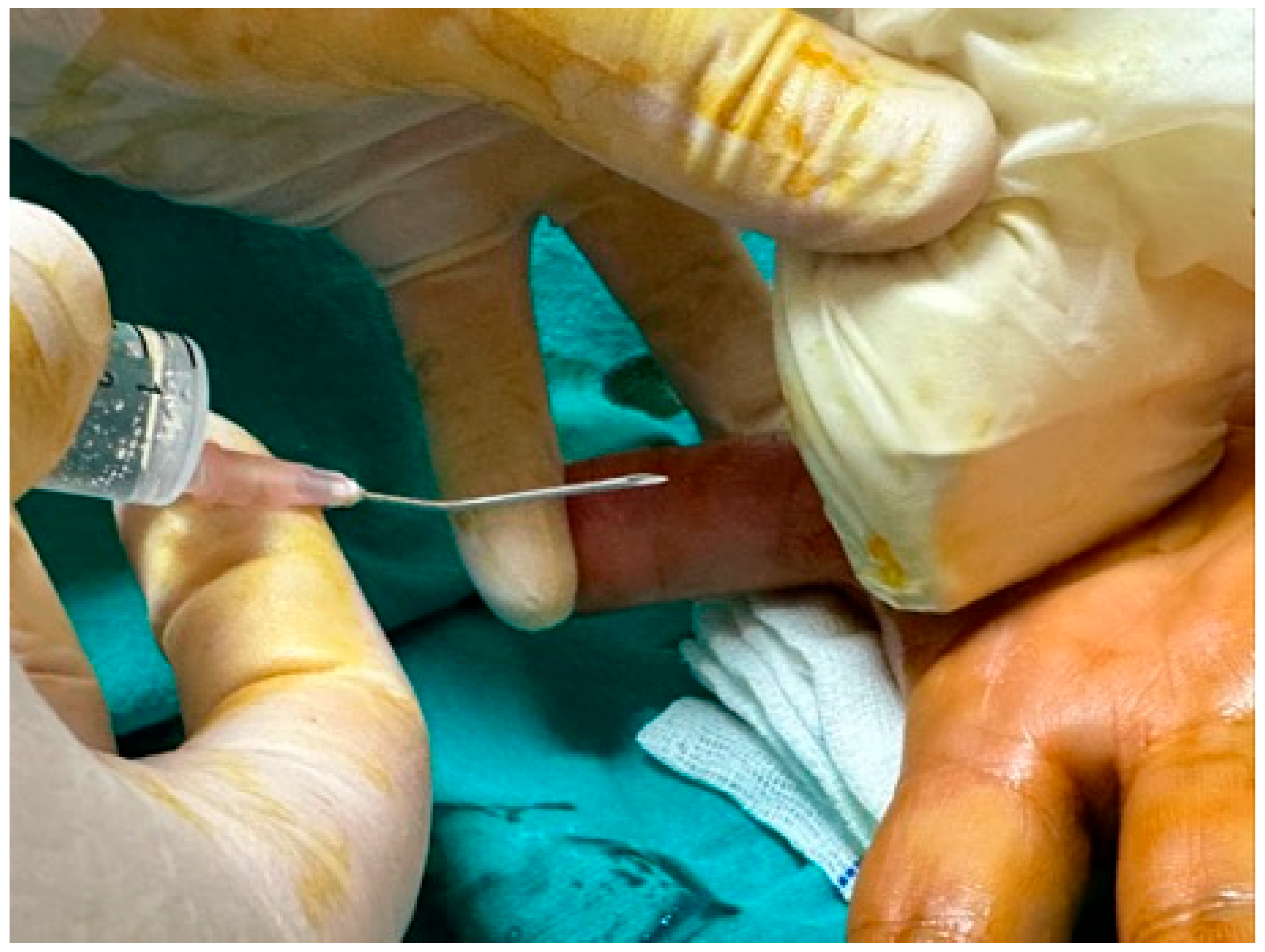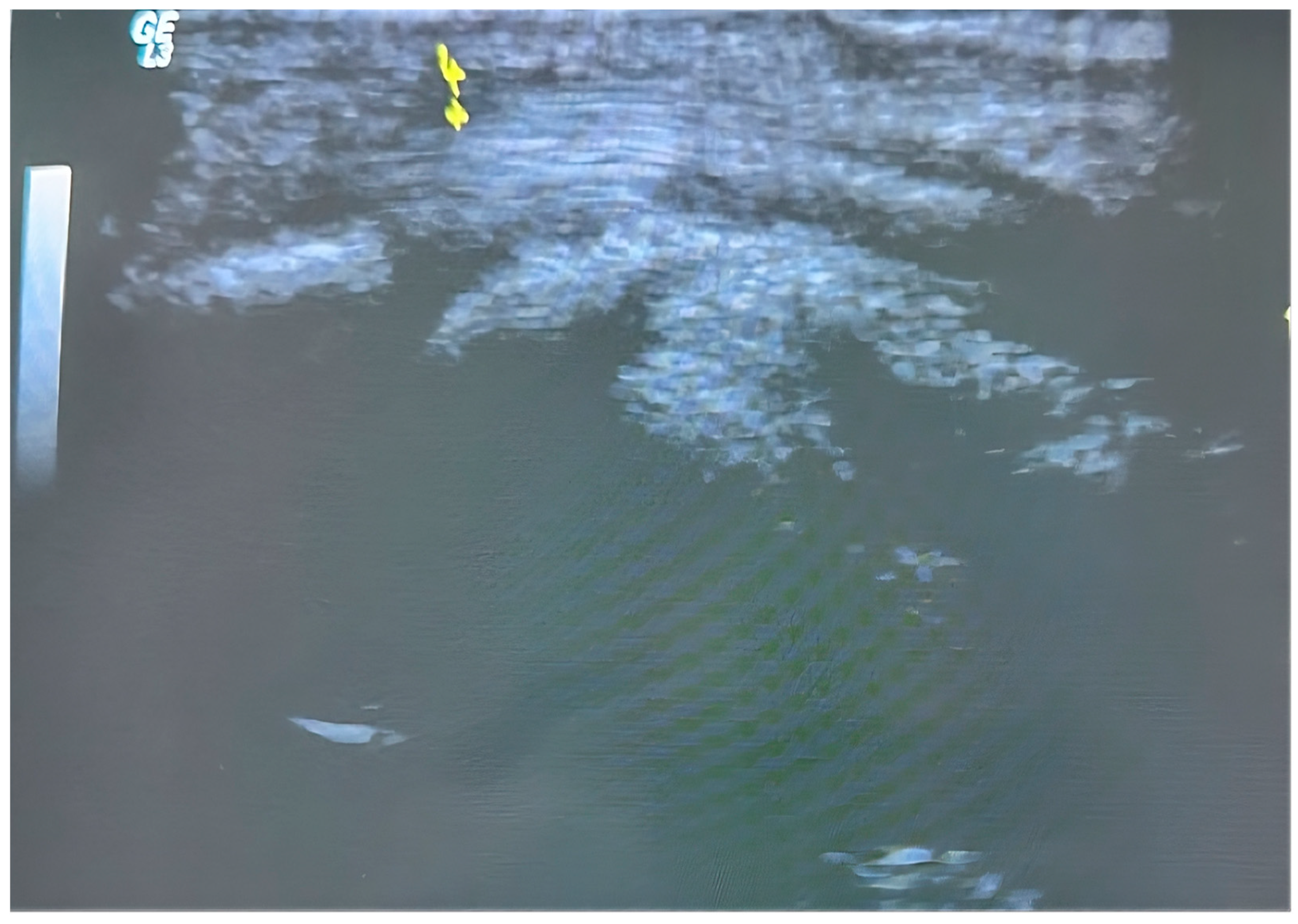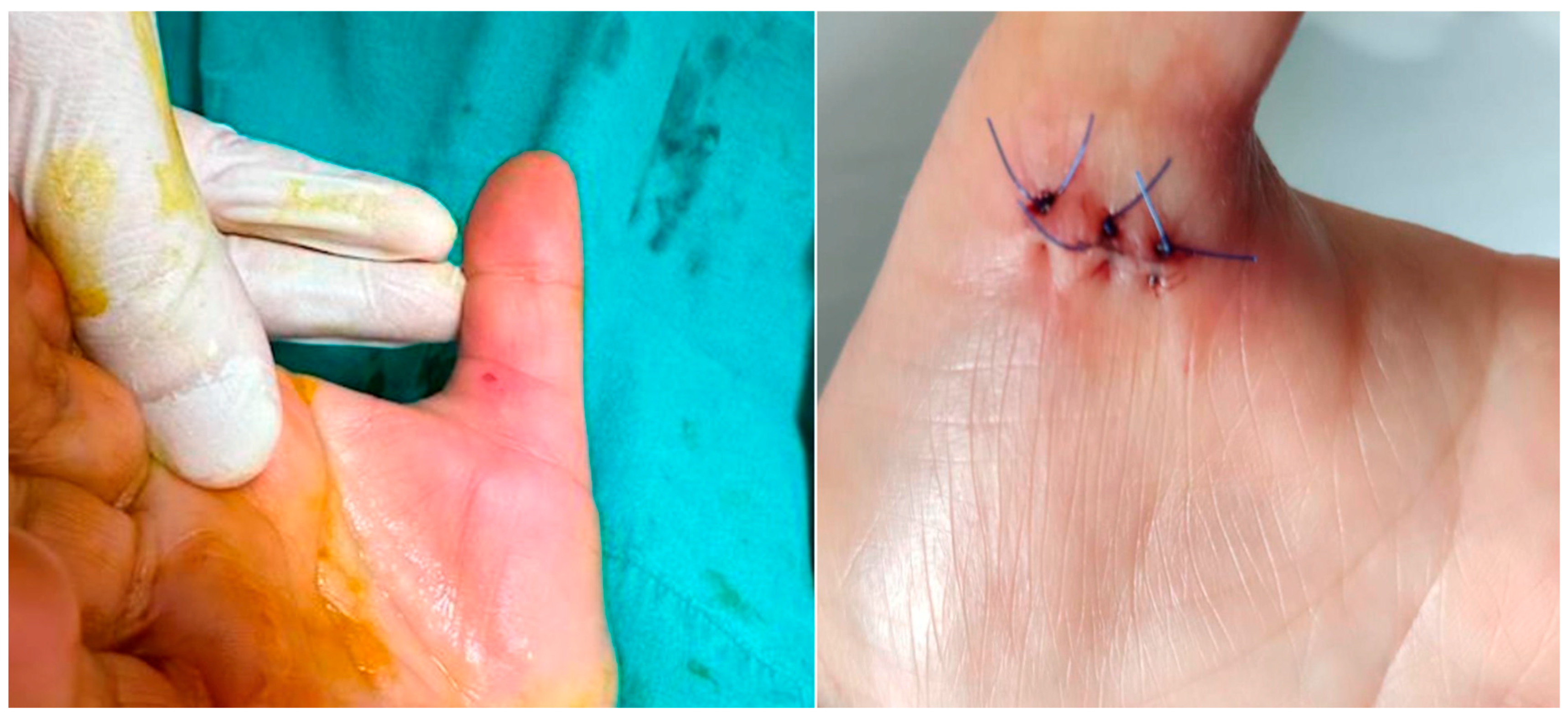Ultrasound-Guided Percutaneous Versus Open A1 Pulley Release for Trigger Finger: A Randomized Controlled Trial
Abstract
1. Introduction
2. Materials and Methods
2.1. Study Design and Ethical Approval
2.2. Patient Selection
- Age ≥ 18 years.
- Diagnosis of according to Green’s classification stage 2–4 trigger finger.
- Symptoms lasting ≥3 months.
- No prior treatment (including corticosteroid injections, splinting, physiotherapy, or surgery) for the affected finger.
- According to Green’s classification stage 1 trigger finger.
- Previous surgery for trigger finger in the same region.
- Rheumatoid arthritis, osteoarthritis, or De Quervain’s tenosynovitis, Dupuytren’s disease.
- Bony deformities.
- Pregnancy.
2.3. Preoperative Evaluation
2.4. Surgical Techniques Open Release
2.5. Ultrasound-Guided Percutaneous Release
2.6. Postoperative Follow-Up
2.7. Statistical Analysis
3. Results
3.1. Functional Scores
- QuickDASH scores were significantly higher in the UGPR group on postoperative day 3 and at the first month (p < 0.05), but scores were comparable between groups at 6 and 12 months (Table 2).
- VAS and Nirschl Phase Rating Scale (NPRS) scores followed a similar trend: higher in the early period in the UGPR group, but no significant difference at the final follow-up (p > 0.05) (Table 2).
3.2. Grip Strength
- At 12 months, the pinch strength values measured with a digital pinchmeter were significantly higher in the UGPR group compared to the open surgery group (p < 0.05), indicating better long-term functional recovery (Table 3).
- Ultrasonographic Measurements.
- The increase in flexor tendon thickness at the metacarpophalangeal (MCP) joint level was significantly greater in the open surgery group (p < 0.05).
- No significant difference was observed between groups in A1 pulley thickness at 12 months (Table 4).
3.3. Complications
- A total of 6 patients (4.1%) experienced complications: 5 in the open surgery group and 1 in the UGPR group. Complications such as incomplete release occurred in 1 patient from the UGPR group. Additionally, revision surgery was required in 4 patients of the UGPR group due to persistent or recurrent triggering, which we reported separately from complications, but this difference did not reach statistical significance (p > 0.05).
- In the UGPR group, four complications/revisions were observed, while none occurred in the open surgery group. One stage 3 thumb case developed a flexor tendon rupture, identified at the first postoperative week, which required surgical repair. Two stage 3 patients experienced recurrent pain and tenosynovitis; one was managed with re-operation using open release, and the other with conservative treatment including steroid injection and physiotherapy. In one patient, digital artery and nerve injury occurred intraoperatively. All patients recovered satisfactorily, although mild residual paresthesia persisted in the neurovascular injury case. No revisions or major complications were noted in the open group.
4. Discussion
5. Limitations
Supplementary Materials
Author Contributions
Funding
Institutional Review Board Statement
Informed Consent Statement
Data Availability Statement
Conflicts of Interest
Abbreviations
| UGPR | Ultrasound-guided percutaneous release |
| kg | Kilograms |
| ASHT | American Society of Hand Therapists |
| NPRS | Nirschl Phase Rating Scale |
| VAS | Visual Analog Scale |
| QuickDASH | Quick Disabilities of the Arm, Shoulder, and Hand |
| USG | Ultrasonographic |
| MCP | Metacarpophalangeal |
References
- Nikolaou, V.S.; Malahias, M.-A.; Kaseta, M.-K.; Sourlas, I.; Babis, G.C. Comparative clinical study of ultrasound-guided A1 pulley release vs open surgical intervention in the treatment of trigger finger. World J. Orthop. 2017, 8, 163–169. [Google Scholar] [CrossRef] [PubMed]
- Dogru, M.; Erduran, M.; Narin, S. The Effect of Radial Extracorporeal Shock Wave Therapy in the Treatment of Trigger Finger. Cureus 2020, 12, e8385. [Google Scholar] [CrossRef] [PubMed]
- Wolfe, S.W. Tenosynovitis. In Green’s Operative Hand Surgery, 5th ed.; Green, D.P., Hotchkiss, R.N., Pederson, W.C., Wolfe, S.W., Eds.; Churchill Livingstone: Philadelphia, PA, USA, 2005; Volume 2, pp. 2137–2158. [Google Scholar]
- Brown, E.; Genoway, K.A. Impact of diabetes on outcomes in hand surgery. J. Hand Surg. 2011, 36, 2067–2072. [Google Scholar] [CrossRef] [PubMed]
- Paulius, K.L.; Maguina, P. Ultrasound-assisted percutaneous trigger finger release: Is it safe? Hand 2009, 4, 35–37. [Google Scholar] [CrossRef]
- Rajeswaran, G.; Healy, J.C.; Lee, J.C. Percutaneous Release Procedures: Trigger Finger and Carpal Tunnel. Semin. Musculoskelet. Radiol. 2016, 20, 432–440. [Google Scholar] [CrossRef]
- Rojo-Manaute, J.M.; Rodríguez-Maruri, G.; Capa-Grasa, A.; Chana-Rodríguez, F.; Soto, M.D.V.; Martín, J.V. Sonographically guided intrasheath percutaneous release of the first annular pulley for trigger digits, part 1: Clinical efficacy and safety. J. Ultrasound Med. 2012, 31, 417–424. [Google Scholar] [CrossRef]
- Pages, L.; Cambon, A. Ultrasound-guided percutaneous opening of the A1 pulley with surgical knife on anterograde versus retrograde approach: A comparative cadaver study (40 fingers). Hand Surg. Rehabil. 2023, 42, 512–516. [Google Scholar] [CrossRef]
- Liang, Y.-S.; Chen, L.-Y.; Cui, Y.-Y.; Du, C.-X.; Xu, Y.-X.; Yin, L.-H. Ultrasound-guided acupotomy for trigger finger: A systematic review and meta-analysis. J. Orthop. Surg. Res. 2023, 18, 678. [Google Scholar] [CrossRef]
- Park, K.-H.; Shin, W.-J.; Kim, S.-J.; Kim, J.-P. Does Bowstringing Affect Hand Function in Patients Treated With A1 Pulley Release for Trigger Fingers? Comparison Between Percutaneous Versus Open Technique. Ann. Plast. Surg. 2018, 81, 537–543. [Google Scholar] [CrossRef]
- Garcia, H.R.P.; Mund, E.; Romeiro, P. Ultrasound-guided vs. non-guided trigger finger release: A systematic review and meta-analysis. Int. Orthop. 2024, 48, 2429–2437. [Google Scholar] [CrossRef]
- Lan, X.; Xiao, L.; Chen, B.; Xiong, Y.; Zou, L.; Luo, J. A Comparison of the Outcomes of Open Trigger Release versus Ultrasound-Guided Modified Small Needle-Knife Percutaneous Release for Treatment of Trigger Digits. J. Hand Surg. 2023, 28, 69–74. [Google Scholar] [CrossRef]
- Boretto, J.; Alfie, V.; Donndorff, A.; Gallucci, G.; De Carli, P. A prospective clinical study of the A1 pulley in trigger thumbs. J. Hand Surg. 2008, 33, 260–265. [Google Scholar] [CrossRef]
- Sampson, S.P.; Badalamente, M.A.; Hurst, L.C.; Seidman, J. Pathobiology of the human A1 pulley in trigger finger. J. Hand Surg. 1991, 16, 714–721. [Google Scholar] [CrossRef] [PubMed]
- Sato, J.; Ishii, Y.; Noguchi, H.; Takeda, M. Sonographic analyses of pulley and flexor tendon in idiopathic trigger finger with interphalangeal joint contracture. Ultrasound Med. Biol. 2014, 40, 1146–1153. [Google Scholar] [CrossRef] [PubMed]
- Guerini, H.; Pessis, E.; Theumann, N.; Le Quintrec, J.-S.; Campagna, R.; Chevrot, A.; Feydy, A.; Drapé, J.-L. Sonographic appearance of trigger fingers. J. Ultrasound Med. 2008, 27, 1407–1413. [Google Scholar] [CrossRef] [PubMed]
- Fiorini, H.J.; Santos, J.B.; Hirakawa, C.K.; Sato, E.S.; Faloppa, F.; Albertoni, W.M. Anatomical study of the A1 pulley: Length and location by means of cutaneous landmarks on the palmar surface. J. Hand Surg. 2011, 36, 464–468. [Google Scholar] [CrossRef]
- Villanova, F.J.F.; Martinel, V.; Marès, O. Ultrasound-guided trigger thumb release. Hand Surg. Rehabil. 2025, 44, 102084. [Google Scholar] [CrossRef]
- Lapègue, F.; André, A.; Meyrignac, O.; Pasquier-Bernachot, E.; Dupré, P.; Brun, C.; Bakouche, S.; Chiavassa-Gandois, H.; Sans, N.; Faruch, M. US-guided Percutaneous Release of the Trigger Finger by Using a 21-gauge Needle: A Prospective Study of 60 Cases. Radiology 2016, 280, 493–499. [Google Scholar] [CrossRef]
- Cebesoy, O.; Karakurum, G.; Kose, K.C.; Baltaci, E.T.; Isik, M. Percutaneous release of the trigger thumb: Is it safe, cheap and effective? Int. Orthop. 2007, 31, 345–349, reprinted in Int. Orthop. 2007, 31, 351. [Google Scholar] [CrossRef]
- Ryzewicz, M.; Wolf, J.M. Trigger digits: Principles, management, and complications. J. Hand Surg. 2006, 31, 135–146. [Google Scholar] [CrossRef]
- Chan, J.K.K.; Choa, R.M.; Chung, D.; Sleat, G.; Warwick, R.; Smith, G.D. High resolution ultrasonography of the hand and wrist: Three-year experience at a District General Hospital Trust. Hand Surg. 2010, 15, 177–183. [Google Scholar] [CrossRef]
- Amro, S.; Kashbour, M.; Abdelgalil, M.S.; Qafesha, R.M.; Eldeeb, H. Efficacy of Ultrasound-Guided Tendon Release for Trigger Finger Compared With Open Surgery: A Systematic Review and Meta-Analysis. J. Ultrasound Med. 2024, 43, 657–669. [Google Scholar] [CrossRef]
- Rodríguez-Maruri, G.; Rojo-Manaute, J.M.; Capa-Grasa, A.; Rodríguez, F.C.; López, E.C.; Martín, J.V. Ultrasound-Guided A1 Pulley Release Versus Classic Open Surgery for Trigger Digit: A Randomized Clinical Trial. J. Ultrasound Med. 2023, 42, 1267–1275. [Google Scholar] [CrossRef]



| Method | ||||
|---|---|---|---|---|
| All Patients | USG (n = 75) | Open (n = 71) | p-Value | |
| Age † | 58.3 ± 9.6 | 57.4 ± 10.1 | 59.2 ± 9.0 | 0.246 * |
| Sex ‡ | ||||
| Male | 37 (25.3) | 18 (24.0) | 19 (26.8) | 0.847 ** |
| Female | 109 (74.7) | 57 (76.0) | 52 (73.2) | |
| Finger ‡ | ||||
| 1 Finger | 67 (45.9) | 44 (58.7) | 23 (32.4) | 0.030 ** |
| 2 Finger | 11 (7.5) | 5 (6.7) | 6 (8.5) | |
| 3 Finger | 25 (17.1) | 9 (12.0) | 16 (22.5) | |
| 4 Finger | 38 (26.0) | 15 (20.0) | 23 (32.4) | |
| 5 Finger | 5 (3.4) | 2 (2.7) | 3 (4.2) | |
| Hand Direction ‡ | ||||
| Left | 54 (37.0) | 29 (38.7) | 25 (35.2) | 0.794 ** |
| Right | 92 (63.0) | 46 (61.3) | 46 (64.8) | |
| Green Classification ‡ | ||||
| Stage 2 | 91 (62.3) | 52 (69.3) | 39 (54.9) | 0.212 ** |
| Stage 3 | 51 (34.9) | 21 (28.0) | 30 (42.3) | |
| Stage 4 | 4 (2.7) | 2 (2.7) | 2 (2.8) | |
| Complication + ‡ | 6 (4.1) | 1 (1.3) | 5 (7.0) | 0.109 ** |
| Revision, + ‡ | 4 (2.7) | 4 (5.3) | 0 (0.0) | 0.120 ** |
| Method | ||||
| USG (n = 75) | Open (n = 71) | p-Value | ||
| VAS | ||||
| 0 | 6.0 [4.0–8.0] | 6.0 [4.0–8.0] | 0.409 | |
| 3 | 6.0 [4.0–9.0] | 4.0 [3.0–7.0] | <0.001 | |
| 1 Month | 2.0 [0.0–5.0] | 2.0 [0.0–4.0] | 0.053 | |
| 6 Month | 0.0 [0.0–3.0] | 0.0 [0.0–2.0] | 0.420 | |
| 12 Month | 0.0 [0.0–1.0] | 0.0 [0.0–1.0] | 0.561 | |
| p-value ** | <0.001 | <0.001 | ||
| Method | |||
|---|---|---|---|
| USG (n = 75) | Open (n = 71) | p-Value | |
| DASH | |||
| 0 | 38.6 [25.0–61.3] | 40.9 [25.0–61.3] | 0.710 |
| 3 | 40.9 [25.0–61.3] | 34.0 [20.4–59.0] | <0.001 |
| 1 Month | 7.9 [4.5–43.1] | 4.5 [2.2–11.3] | <0.001 |
| 6 Month | 2.2 [0.0–4.5] | 2.2 [0.0–4.5] | 0.409 |
| 12 Month | 0.0 [0.0–9.0] | 0.0 [0.0–2.2] | 0.297 |
| p-value ** | <0.001 | <0.001 | |
| Method | |||
| USG (n = 75) | Open (n = 71) | p-Value | |
| NİRSCHL | |||
| 0 | 4.0 [2.0–6.0] | 4.0 [2.0–6.0] | 0.499 |
| 3 | 5.0 [3.0–7.0] | 3.0 [2.0–5.0] | <0.001 |
| 1 Month | 2.0 [0.0–5.0] | 2.0 [0.0–5.0] | 0.081 |
| 6 Month | 0.0 [0.0–2.0] | 0.0 [0.0–2.0] | 0.409 |
| 12 Month | 0.0 [0.0–1.0] | 0.0 [0.0–1.0] | 0.650 |
| p-value ** | <0.001 | <0.001 | |
| Method | |||
|---|---|---|---|
| USG (n = 75) | Open (n = 71) | p-Value * | |
| Pinchmetre | |||
| 0 | 4.2 [0.8–7.4] | 3.3 [0.6–7.1] | 0.059 |
| 12 Month | 5.2 [1.1–9.1] | 4.0 [1.1–9.3] | 0.008 |
| p-value ** | <0.001 | <0.001 | |
| Method | |||
|---|---|---|---|
| USG (n = 75) | Open (n = 71) | p-Value * | |
| Pulley Thickness | |||
| 0 | 1.4 [1.1–1.8] | 1.3 [0.9–1.7] | <0.053 |
| 12 Month | 0.4 [0.2–0.9] | - | - |
| p-value ** | <0.001 | - | |
| Δ Pulley thickness | −66.67 [−84.09–−40] | - | - |
| Method | |||
| USG (n = 75) | Open (n = 71) | p-Value * | |
| MCP fleksör Tend | |||
| 0 | 3.4 [2.7–5.0] | 3.1 [2.6–4.1] | <0.001 |
| 12 Month | 3.8 [2.8–6.3] | 3.6 [2.8–4.5] | 0.086 |
| p-value ** | <0.001 | <0.001 | |
| Δ MCP flexor tendon | 7.14 [−21.62–85.29] | 12.43 [−3.23–22.92] | <0.001 |
Disclaimer/Publisher’s Note: The statements, opinions and data contained in all publications are solely those of the individual author(s) and contributor(s) and not of MDPI and/or the editor(s). MDPI and/or the editor(s) disclaim responsibility for any injury to people or property resulting from any ideas, methods, instructions or products referred to in the content. |
© 2025 by the authors. Licensee MDPI, Basel, Switzerland. This article is an open access article distributed under the terms and conditions of the Creative Commons Attribution (CC BY) license (https://creativecommons.org/licenses/by/4.0/).
Share and Cite
Öner, S.K.; Demirkiran, N.D.; Dulgeroglu, T.C.; Kuyubasi, S.N.; Kozlu, S.; Yılmaz, S. Ultrasound-Guided Percutaneous Versus Open A1 Pulley Release for Trigger Finger: A Randomized Controlled Trial. J. Clin. Med. 2025, 14, 7064. https://doi.org/10.3390/jcm14197064
Öner SK, Demirkiran ND, Dulgeroglu TC, Kuyubasi SN, Kozlu S, Yılmaz S. Ultrasound-Guided Percutaneous Versus Open A1 Pulley Release for Trigger Finger: A Randomized Controlled Trial. Journal of Clinical Medicine. 2025; 14(19):7064. https://doi.org/10.3390/jcm14197064
Chicago/Turabian StyleÖner, Süleyman Kaan, Nihat Demirhan Demirkiran, Turan Cihan Dulgeroglu, Sabit Numan Kuyubasi, Suleyman Kozlu, and Selçuk Yılmaz. 2025. "Ultrasound-Guided Percutaneous Versus Open A1 Pulley Release for Trigger Finger: A Randomized Controlled Trial" Journal of Clinical Medicine 14, no. 19: 7064. https://doi.org/10.3390/jcm14197064
APA StyleÖner, S. K., Demirkiran, N. D., Dulgeroglu, T. C., Kuyubasi, S. N., Kozlu, S., & Yılmaz, S. (2025). Ultrasound-Guided Percutaneous Versus Open A1 Pulley Release for Trigger Finger: A Randomized Controlled Trial. Journal of Clinical Medicine, 14(19), 7064. https://doi.org/10.3390/jcm14197064







